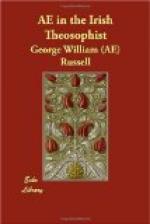Beyond waking, dreaming and deep sleep is Turya. Here there is a complete change of condition; the knowledge formerly sought in the external world is now present within the consciousness; the ideations of universal mind are manifest in spiritual intuitions. The entrance to this state is through Jagrata, Svapna, and Sushupti, and here that spiritual unity is realized, the longing for which draws the soul upwards through the shadowy worlds of dreaming and deep sleep. I have thought it necessary to supplement the brief statement made in the previous number by some further remarks upon concentration, for the term applied without reference to the Turya state is liable to be misunderstood and a false impression might arise that the spiritual is something to be sought for outside ourselves. The waking, dreaming and deep sleep states correspond to objective worlds, while Turya is subjective, including in itself all ideals. If this is so, we can never seek for the true beyond ourselves; the things we suppose we shall come sometime realize in spiritual consciousness must be present in it now, for to spirit all things are eternally present. Advance to this state is measured by the realization of moods: we are on the path when there surges up in the innermost recesses of our being the cry of the long imprisoned souls of men; we are then on our way to unity.
The Bhagavad-Gita which is a treatise on Raj Yoga, gives prominence to three aspects of concentration. Liberation is attained by means of action, by devotion, by spiritual discernment; these aspects correspond respectively to three qualities in man and nature, known as Tamas, Rajas and Satva. The Tamas is the gross, material or dark quality; Rajas is active and passional; the attributes of Satva are light, peace, happiness, wisdom. No one while in the body can escape from the action of the three qualities, for they are brought about by nature which is compounded of them. We have to recognize this, and to continue action, aspiration and thought, impersonally or with some universal motive, in the manner nature accomplishes these things. Not one of these methods can be laid aside or ignored, for the Spirit moveth within all, these are its works, and we have to learn to identify ourselves with the moving forces of nature.
Having always this idea of brotherhood or unity in mind, by action— which we may interpret as service in some humanitarian movement— we purify the Tamas.
By a pure motive, which is the Philosopher’s Stone, a potent force in the alchemy of nature, we change the gross into the subtle, we initiate that evolution which shall finally make the vesture of the soul of the rare, long-sought-for, primordial substance. Devotion is the highest possibility for the Rajas; that quality which is ever attracted and seduced by the beautiful mayas of fame, wealth and power, should be directed to that which it really seeks for, the eternal universal life; the channels through which




